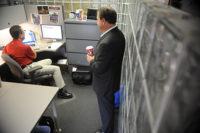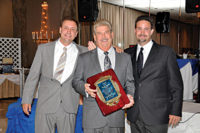According to the University of California-Berkeley’s Center for the Built Environment (CBE), studies of occupants in commercial buildings have shown that “noise is probably the most prevalent annoyance source in offices.” To combat noise problems that leave occupants dissatisfied with their indoor environment, the importance of HVAC equipment and system acoustics should not be ignored.
“Noise and vibration radiating from HVAC equipment is one of the biggest complaints of building occupants,” said Nathan Redman, director of sales, HVAC vibration, seismic, and wind restraint markets for Kinetics Noise Control.
Yet, as the CBE has noted, “acoustics, in most cases, do not receive the level of design attention as thermal, ventilation, and other architectural and engineering considerations.”
While there are a variety of HVAC system issues that can negatively affect building acoustics, experts say that minimizing noise and vibration is easiest to achieve when starting with a good design.
Cause of Complaints
When occupants complain about unwanted noise related to their HVAC systems, a thorough investigation is needed to uncover the real source of the acoustical problem.
“To an occupant, noise is any sound that distracts him or her from the task at hand, but, to address a noise problem, it is necessary to look a little deeper,” said Dave Guckelberger, applications engineer, Trane, a brand of Ingersoll Rand.
He explained: “Noise could be the result of a vibration problem, poor sound quality, or a system that is just too loud. The distinction is important because the solution is different in each case. For example, poor sound quality can sometimes be addressed by adding additional sound — a solution that would not work for the other two categories.”
In the simplest cases, Guckelberger said, “The problem can be traced to a malfunctioning unit.”
That’s when it’s easy to fix the problem by fixing the unit, he said. However, when the units are functioning properly and have been installed correctly, solving acoustical problems becomes more challenging.
“If there are no installation issues, such as shorted isolators, the problem is most likely the result of system design. It is typical for an acoustical analysis done after the unit is installed to predict sound levels similar to those measured in the space. And, while the reduction of sound after the fact is possible, it is always more difficult,” he noted.
According to Lily Mak, senior product manager, commercial splits, heating, and IAQ, Lennox Industries Inc., “The most common complaint from building occupants is about air noise.”
Mak offered two possible approaches to alleviate this concern. First, she pointed to blower operation. “Low-frequency rumble comes from running the blower at an unstable operating point and should be remedied by changing the blower speed,” she said.
She further noted the duct system should be inspected.
“High-frequency air noise comes from excessive air velocity, and/or too direct of an airpath from the noise source to the occupant. Good duct design practices may address this problem.”
Guckelberger added: “High on the list of installation problems for ducted equipment is ductwork that causes an abrupt change in airflow direction. Elbows near the fan, back-to-back elbows, and poorly designed duct transitions are common culprits.”
Brian Wathen, commercial marketing manager, Johnson Controls, unitary products group, noted duct design must not be overlooked when it comes to acoustic concerns.
“In general, when people complain about noise coming from the air conditioning system, they tend to blame the HVAC unit itself, but, in reality, the undesirable noise levels may be related to duct and/or building design,” he said. “If the ductwork isn’t properly designed for the building, air movement will contribute to greater noise levels as well as poor building acoustics.”
Lahnie Johnson, president and founder, Acoustiblok Inc., noted there is typically a combination of noise sources in commercial buildings. “The most common complaints we see are noise from chillers, vacuum pumps, compressors, and air handlers.”
Good Design Prevents Complaints
According to several sources, when working on commercial projects, the old saying “an ounce of prevention is worth a pound of cure” is certainly true when it comes to acoustics. Many noise and vibration problems can be completely avoided through smart design and in-depth acoustical analysis.
“The best measure for prevention is to design and specify proper products to control issues of noise and vibration during the initial design phase of commercial building projects,” Redman said.
The first step is to pay attention to the location of HVAC equipment.
“In new construction, installing the equipment so that it is not directly above a noise-sensitive area is a good start,” Mak said. “Next, developing a good layout for the duct system will ease the way to satisfactory performance. This includes attention to locations of system returns and diffusers as well as appropriate duct sizing.”
She stressed that, during the design stage, “The design engineer or the design-build HVAC contractor has the opportunity to keep duct pressurization and duct velocity within recommended limits, and to select register types and locations that consider the needs of the occupants.”
Skip Ernst, marketing manager, Daikin Applied, said acoustical achievement is obtained through the smallest technicalities.
“Details are important,” he said. “All ductwork and sound-deadening materials must be installed as specified. Equipment room walls must be sealed, and duct transitions and turns must be as smooth as possible. Also, equipment should be selected that actually meets the project’s and local city’s sound pressure and 1/3 octave band specifications.”
Ernst also offered specific tips for improving acoustics with air-cooled chillers.
“After the design of the machine, the placement of an air-cooled chiller has the largest impact on overall sound pressure levels,” he said. “Relation to reflecting surfaces, line of sight to the receiver, and distance to the receiver can dramatically impact sound quality for building occupants as well as the outside environment. Great care should be taken regarding placement of the machine and reflecting walls. Consult with the manufacturer for sound-pressure estimates at each receiver location.”
Overall, Guckelberger said, “The best way to reduce noise complaints is to be proactive.”
He explained that being proactive means the building design process must include a thorough acoustical analysis based on accurate sound data.
He added that Trane supports acoustical analysis with its modeling software, the Trane Acoustics Program (TAP).
“TAP is an acoustical modeling software tool that makes it easy to accurately predict how sound from HVAC equipment will impact the building’s occupants and neighbors,” he explained. “TAP can compare the sound characteristics of several system alternatives to determine the quietest, most cost-effective design.”
From Product Development to Aftermarket
On the back end, HVAC manufacturers are doing their part to ensure the units coming off production lines are quieter than ever. And on the front end, aftermarket accessory manufacturers are providing an array of solutions designed to further minimize noise and vibration.
At Johnson Controls, Wathen said the company is working to decrease noise levels.
“For example, UPG [unitary products group] recently introduced the York Prestige, Coleman Peak, and Luxaire Eclipse exact-fit replacement rooftop units. These units feature embossed top panels that prevent excess vibration,” he said. “Excess vibration could ultimately lead to increased noise, so the embossments help decrease noise levels.”
According to Mak, Lennox is focusing on minimizing sound and vibration transmission to the occupied space. “For structure-borne noise reduction, we have established vibration limits for mechanical systems, and we measure G-forces and deflections of important components during the product development process. If a limit is exceeded, that signals the need for redesign or vibration dampening,” she said.
Mak also noted that Lennox pays attention to acoustics during component selection.
“The selection of components, such as compressor, fan, and blower systems are important,” she said. “Sometimes internal piping and structural panels can also be a vibration/noise source, so these are also checked. Systems with variable-speed blowers and even variable-speed compressors tend to be less acoustically obtrusive, in part, because of the soft start-up and shutdown.”
From a product development standpoint, Guckelberger said Trane is always researching “new ways to reduce the sound energy produced by its equipment.”
He continued, “All product development projects include acoustical goals used to integrate the research and development of sound-reducing technology into the products Trane sells.”
Ernst also commented on the sound generated by air-cooled chillers, which he noted “is often a concern in commercial buildings, not only for the occupants inside the building, but also for the environment outside the building.”
To alleviate this concern, he said the Daikin Pathfinder air-cooled screw chiller “includes an acoustically designed sound-dampening discharge plenum built into each compressor as standard, which greatly reduces the overall A-weighted sound pressure from the chiller.”
In addition, Ernst pointed out there are aftermarket options geared to improve acoustic quality.
“Once the building is in operation, and the air-cooled chiller is installed and running, there are a few options for the building owner to reduce noise complaints. There are aftermarket options available to ‘wrap’ the compressors on the machine, and sound-deadening materials can be applied to acoustical walls,” he said.
To resolve HVAC noise problems, Johnson described the most common products his company recommends. “Most often, the projects we provide products for require a combination of sound abatement products to resolve the noise problems,” he said. “The three most common products used for HVAC noises are QuietFiber, Acoustiblok material, and AllWeather Sound Panels.”
He explained that QuietFiber is a non-fiberglass material designed to absorb sound, and Acoustiblok material is a viscoelastic polymer material typically added to stud walls to block noise. The AllWeather Sound Panels are a hybrid that both absorb and block noise, he said. “They are comprised of several layers of very different types of materials to maximize noise abatement.”
Redman also listed the most common products his company offers for HVAC acoustical concerns, including HVAC silencers, acoustic louvers, pressurized plenums, composite sound curtains, and vibration isolation rooftop curbs.
Describing a few of the products in more detail, he noted a key feature of the curtains is their versatility. The composite sound curtains can be used as HVAC equipment enclosures, pipe and duct wrap, or equipment rooms liners.
Redman also highlighted the vibration isolation rooftop curbs.
“[They] control noise and vibration of packaged, curb-mounted mechanical equipment from the roof structure and internal building spaces,” he said.
Acoustic Awareness
As awareness of acoustics improves and the HVAC industry continues to focus on this aspect of indoor environmental quality, there is hope that building occupants will have less noise to complain about in the future.
“Architects, engineers, consultants, and contractors now understand the need for proper implementation of noise and vibration control solutions when designing commercial buildings,” Redman said. “This understanding can be attributed to past experiences and dissatisfied occupants.”
Looking further down the road, he noted, “As we evolve over time, we will see more advanced noise-control options, and also the incorporation of vibration isolation and noise control as a single, easy-to-install package.”
Publication date: 7/14/2014
Want more HVAC industry news and information? Join The NEWS on Facebook, Twitter, and LinkedIn today!














